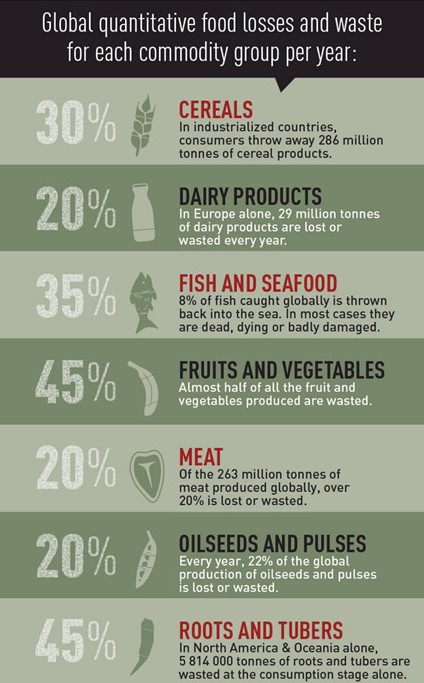Targeting food loss and waste with innovative packaging

Ana Fernandez, Global Innovation Director, Food Packaging
Nearly one-third of all food produced globally each year is lost or wasted. This is a shocking statistic, especially as this would feed more than twice the number of people that go to bed hungry every night. Why does this happen, and what is plastic packaging’s role in delivering a solution?
At kp, our focus is on the sustainable protection of everyday needs. We create innovative films and trays which help avoid food waste and protect the integrity of their contents.
Working within the industry I’m very mindful of plastic packaging’s environmental impacts; I’d never ignore that. But I do think we need to collaborate to reduce food loss and waste, and to ensure everyone has an understanding of the benefits food packaging can bring. We obviously need to reduce our dependency on single-use plastics but, very often, plastic is the most appropriate material when the focus is to extend shelf life.
Firstly, let’s make a distinction between food loss and food waste:
- Food loss refers to food becoming unfit for human consumption unintentionally due to lack of refrigeration, damage while it's being loaded, offloaded, or transported between harvest and retail sale. Approximately 14% of the world’s food is lost between harvest and retail sale1 , which amounts to at least 400 billion USD.
- Food waste happens at the retail, food service and the consumer or household levels, when food that could be eaten is thrown away. Around 17% of food is wasted at the retail and consumer levels; in industrialised countries, more than 40% of the loss happens here. Food waste is one of the largest sources of inefficiency in the agri-food chain. In particular, it results in negative environmental and climate impacts. When food is discarded, all the embedded energy and resources and their environmental consequences, such as GHG emissions – that accumulate along the food chain – still materialise with no benefit for human nutrition. Food which is processed, transported and cooked that is then wasted at consumption stage has a higher environmental impact than unprocessed food products lost at the farm.
Facts like that just confirm that food loss and waste pose a big challenge to food security, food safety, the economy, and environmental sustainability.
According to the Food Waste Index Report 2021/WESR, in 2019 an estimated 931 million tonnes of food went into the waste bins of households, retailers, restaurants, and other food services. Some of this waste will occur as a result of deterioration - and this is exactly what packaging can help to prevent by increasing shelf life.
For each banana or portion of chicken that is thrown away, we’re putting additional strain on natural resources and our environment. When someone ‘double buys’ to replace something that could have been eaten if it had a slightly longer shelf life, they’re effectively using additional raw materials, energy, soil, labour, transportation, and storage. And that’s before we consider greenhouse gases that are produced by decomposing food – it’s worth keeping in mind that wasted food generates 8 to 10% of the world’s greenhouse gases as it decomposes in landfill. Just in Europe 58.5 million tons of food waste2 generated in 2020 caused emissions of 252 million tons of CO2 equivalents3. This corresponds to 16% of the total GHG impact resulting from the EU food system.
Share this story
According to the Food Waste Index Report 2021/WESR, in 2019 an estimated 931 million tonnes of food went into the waste bins of households, retailers, restaurants, and other food services. Some of this waste will occur as a result of deterioration - and this is exactly what packaging can help to prevent by increasing shelf life.
- What is being lost and wasted?
It appears no food group is immune as the infographic shows. And whilst these stats are shocking, this is only part of the picture. As I alluded to earlier, there are environmental consequences attached to these figures.
- Packaging’s durability and preservation can play a role
Whilst we don’t have a solution to food loss here at kp, our latest packaging innovations are helping to tackle food waste. When used in food packaging, plastic contributes to the safe and efficient distribution of our customer’s products and extends the shelf life of perishable products. Our aim is to produce optimised packaging that delivers the required protection using as little material as possible that is fully recyclable, so it protects far more resources than it uses. We’re transitioning our portfolio constantly to ensure all our products are fully recyclable, contain as much recycled content as possible, and are part of the solution, not part of the problem. - Our innovations are delivering change
Our recently launched kp Elite® is a great example of this. It’s a unique recyclable modified atmosphere packaging solution made using up to 100% post-consumer recycled PET. It’s great for fresh protein packaging. With award winning sealing capabilities the trays are lighter, and they seal at lower temperatures more quickly, all whilst extending shelf life between 7 – 10 days which can reduce food waste. It can be combined with kp Zapora® , our padless tray technology, and part of the recycled content can come from Tray2Tray®. Replacing recycled content from bottles with recycled content from trays is at the heart of our kp Tray2Tray® programme. As a result, our plastic trays and rigid films can come back time and again as safe, protective, fully recyclable food packaging trays, in a fully closed loop. - Collaborating to close the loop
People often ask what is stopping us from accelerating to a circular future for plastic packaging. To give you a full answer, I probably need to write another blog. But what I will say is we’re working in partnership across our value chain to promote further development of enabling infrastructure to help close the loop. Once we get that piece of the puzzle scaling up, we’re on the right track.
Having worked at kp for 33 years I’ve seen and helped drive many packaging innovations. We’re focused on supporting our customers to deliver sustainable packaging solutions and to include more and more recycled content in their packaging. We’re never going to stop innovating – my team’s aim is to protect and preserve food, whilst also pushing for full circularity, and we do believe plastic packaging is often the most appropriate material for items such as fresh protein and the likes.
Ana Fernandez
Global Innovation Director, Food Packaging
Innovating to increase shelf life
Ask any kp colleague and they’ll know about our sustainability strategy – Investing in Better – which sees us focus our time and energy on closing the loop, whilst working smarter and acting responsibly. See our Investing in Better sustainability strategy here.
Having worked at kp for 33 years I’ve seen and helped drive many packaging innovations. We’re focused on supporting our customers to deliver sustainable packaging solutions and to include more and more recycled content in their packaging. We’re never going to stop innovating – my team’s aim is to protect and preserve food, whilst also pushing for full circularity, and we do believe plastic packaging is often the most appropriate material for items such as fresh protein and the likes.
I’m really proud of some of our recent product developments that are changing packaging as we know it, whilst meeting safety standards and consumer expectations. We’re also active in conversations on key topics but I want us to come together and do more to tackle food waste.
Having worked at kp for 33 years I’ve seen and helped drive many packaging innovations. We’re focused on supporting our customers to deliver sustainable packaging solutions and to include more and more recycled content in their packaging. We’re never going to stop innovating – my team’s aim is to protect and preserve food, whilst also pushing for full circularity, and we do believe plastic packaging is often the most appropriate material for items such as fresh protein and the likes.
I’m really proud of some of our recent product developments that are changing packaging as we know it, whilst meeting safety standards and consumer expectations. We’re also active in conversations on key topics but I want us to come together and do more to tackle food waste.
Time to wage a war on waste as protection just isn’t enough
Sustainable Development Goal (SDG) 12 seeks to “ensure sustainable consumption and production patterns”. Efforts by the Food and Agriculture Organisation of the United Nations and the UN Environment Programme are underway to measure the progress made towards achieving SDG 12.3 using two separate indices – the Food Loss Index (FLI), led by FAO; and the Food Waste Index (FWI), led by UN Environment. To get a better understanding of the problem, and progress to date, take a look at the interactive charts at sdg12hub.org/sdg-12-hub/see-progress-on-sdg-12-by-target/123-food-loss-waste.
But we still need to do more to shift public perception and drive behaviour change. I recently came across a provocative virtual exhibition that was inspired by global food loss and waste and its impact on the environment. In ‘Grown for a bin’, Austrian artist Klaus Pichler, shows unconsumed food in various states of decay. It makes you stop and think – but how do we then turn this moment of reflection into widespread action? And surely it makes sense to design and utilise packaging to increase shelf lives to prevent food unnecessarily being thrown out?
Each day at work, whether we’re looking at packaging sizing or exploring innovations on new materials or applications, I remain confident there are plenty more smart packaging solutions to come that will go even further to reduce food waste by increasing shelf life. I also hope there will be a paradigm shift – we need to remember that packaging which protects food and increases shelf life has a valuable role to play. And that as end consumers, we all need to dispose of the packaging that makes its way into our homes to facilitate recycling, so materials can be used over and over again to make new packaging that helps to protect our food, as part of a closed loop. We really do understand our obligation and responsibility to champion a circular economy where plastics are a source of valuable raw material. And we know many of our competitors feel the same.
But we still need to do more to shift public perception and drive behaviour change. I recently came across a provocative virtual exhibition that was inspired by global food loss and waste and its impact on the environment. In ‘Grown for a bin’, Austrian artist Klaus Pichler, shows unconsumed food in various states of decay. It makes you stop and think – but how do we then turn this moment of reflection into widespread action? And surely it makes sense to design and utilise packaging to increase shelf lives to prevent food unnecessarily being thrown out?
Each day at work, whether we’re looking at packaging sizing or exploring innovations on new materials or applications, I remain confident there are plenty more smart packaging solutions to come that will go even further to reduce food waste by increasing shelf life. I also hope there will be a paradigm shift – we need to remember that packaging which protects food and increases shelf life has a valuable role to play. And that as end consumers, we all need to dispose of the packaging that makes its way into our homes to facilitate recycling, so materials can be used over and over again to make new packaging that helps to protect our food, as part of a closed loop. We really do understand our obligation and responsibility to champion a circular economy where plastics are a source of valuable raw material. And we know many of our competitors feel the same.
For more information:
More like this








